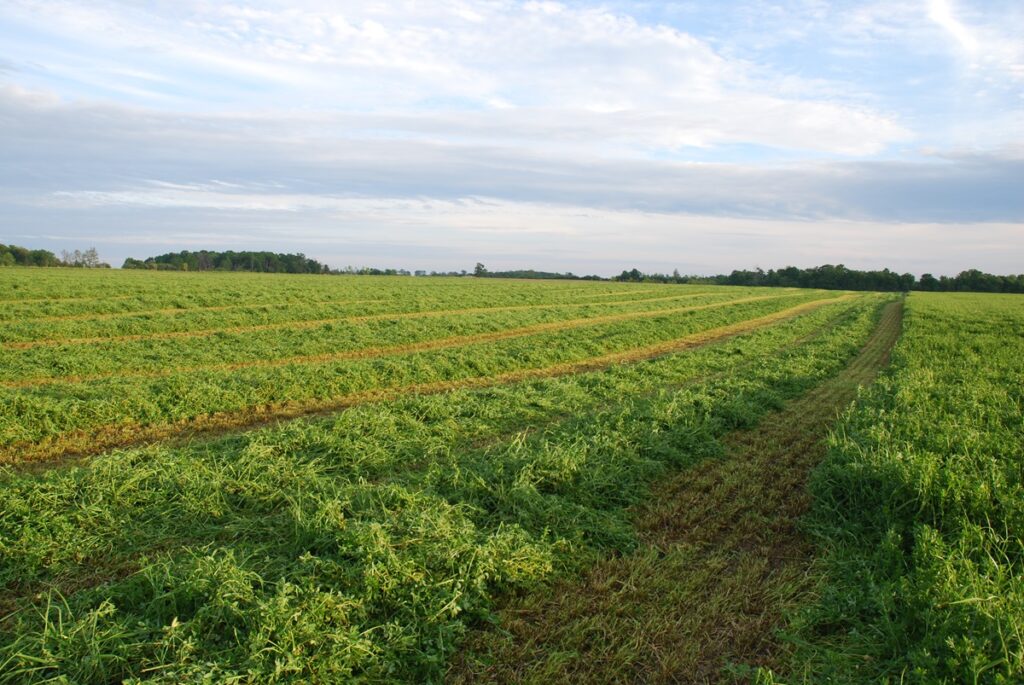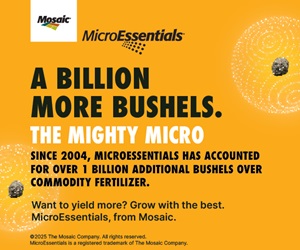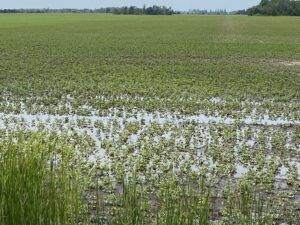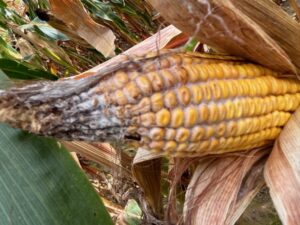Alternative rotation options
IMPROVING SOIL HEALTH AND SUSTAINABILITY

DECLINING COMMODITY PRICES OFTEN HAVE GROWERS ASKING ABOUT OTHER OPTIONS, yet there’s often more to explore with crop alternatives. Spreading workloads, diversifying operations, or lowering risk are a few reasons, while some growers look to lengthen rotations, improve soil health, or improve the sustainability of their farms.
Canola, edible beans, and forages occupy that first level of alternatives for growers wanting to broaden their horizons. The good news is they provide excellent market potential, including solid “grown-in-Ontario” opportunities.
CANOLA
PLUSES: good pricing, increased demand for winter hybrids, spreading workloads, volume- based commodity, increasing market demand in biofuels.
CAUTIONS: only one available winter hybrid, fewer weed control options, familiarity with seed sizes and seeding rates.
Last November, a meeting of the Ontario Canola Growers Association provided important insights on 2023 production. According to Agricorp, insured acres in the province were the highest since 2012, with more than 25,000 acres of spring canola and a jump in winter canola acres — to 11,500 seeded last fall. In total, 2023 acres totalled roughly 44,000 acres.
As Meghan Moran has been telling people, canola can be a profitable crop, provided new growers are made aware of its challenges. Of the three primary alternatives, it’s the least sensitive to quality parameters and is the likeliest fit for a conventional rotation of corn, soybeans, and wheat.
“The real reason for growing canola is to diversify risk,” says Moran, canola and edible bean specialist with the Ontario Ministry of Agriculture, Food and Rural Affairs (OMAFRA). She acknowledges there have been more questions about alternatives since commodity prices began declining last year. “That can mean breaking pest cycles or mixing up herbicide timing — especially with winter- planted canola and different herbicide products that can help mitigate or delay herbicide-resistant weeds.”
She doesn’t believe growers would favour starting with spring canola, especially south of Simcoe County. The rush of spring planting has less effect on winter canola — and edible beans — and both are harvested earlier.
“There may be some adjustments to equipment, like operators learning how to set up their planter for smaller seeds or buying after-market canola plates,” adds Moran. “We can use a drill, but we have to ratchet that seeding rate down as much as we can.”
In marketing winter canola crops, Bunge Milling in Hamilton and Archer Daniel Midland (ADM) in Windsor are the primary choices, with ADM reportedly willing to take as much non-GMO Mercedes as possible. The long- term opportunities for renewable fuels also favour canola.
FINDING THE FIT FOR THE GROWER
Ian Toll has been growing canola for five years, earning a second-place finish in the 2023 Canola Challenge, yielding 5,119 pounds per acre of winter canola. The Blenheim-area grower’s rotation includes winter wheat, corn, and soybeans, along with hay and rye, to feed his 50 beef cattle finishers and more than 600 ewes. His biggest challenge is harvesting winter wheat and then plowing and working the land in time for canola planting by mid-September.
“But it yields great and doesn’t seem to matter how big it gets in the fall — it doesn’t bolt,” says Toll, who farms with his two sons. “The price is up and down with other crops we grow, but it does seem to have more profit at the end of the season. It requires more scouting and more maintenance, but we also double-crop soybeans to help add dollars to that field.”
He purchased a planter just for canola, echoing Moran’s comments about special plates and rollers needed with an air seeder or a planter. The only other concern he expresses is the availability of only one winter canola hybrid. It isn’t a huge challenge given the low number of acres for now, but with expected increases, demand for more hybrids will rise.
“It’s a fit in our area, but start out slow and increase acres over a couple of years,” advises Toll. “The root system is outstanding, and it helps break up the soil. We can see a plus in corn bushels the following year.”
EDIBLE BEANS
PLUSES: higher profitability (compared to soybeans), spreading workloads, equipment compatibility (with small-seeded white, black and adzukis), and good demand for overseas export markets.
CAUTIONS: grown primarily under contract, quality-based market, higher cost of production (including more sprayer passes), fewer herbicide options, need for specialized equipment (with large-seed beans like cranberry and kidneys).
Last October, Moran penned an article for OMAFRA’s website, touting the profitability of dry beans versus soybeans. Despite higher cost of production figures ($409 per acre for crush soybeans, $482 for IP soybeans and $679 for white, black or adzuki beans), edible bean profitability was higher.
Moran concedes smaller-seeded beans — whites, blacks and adzukis — are easier to grow in terms of equipment; a combine used with soybeans will do much the same. Cranberry and kidneys are larger-seeded and harvested with a specialized bean combine, and while it’s not to say those are impossible hurdles to overcome, advanced planning is required.
“Dealers will have a certain number of acres they’re looking to grow based on demand in the export market, but the world will only eat so many beans in a year,” notes Moran, adding edible beans don’t tend to store well. “Generally, though, it sounds like dealers are looking for bean growers, and right now, there’s room for more producers in Ontario.”
LONG HISTORY
Despite arguments against edible beans as an alternative, Mike Donnelly Vanderloo believes there are plenty of positives. As a grower, he started with white beans in the early 1990s and has added cranberry beans, maintaining distinct advantages to the market – despite contracts or frequent passes in a field.
“Edibles aren’t necessarily a soil-building crop, but following them with winter wheat, possibly planted early with a cover crop, will put a lot back into the soil,” says Donnelly- Vanderloo, who farms near Thamesford with his brother Joe. Together, they grow soybeans, corn, winter wheat — with red clover — after edible beans, along with processing peas and sweet corn.
He has a long history working in different crops and advises those looking to enter the market to keep reasonable expectations and understand the importance of quality. Little things like mud-tagging and splits in the seed coat can significantly impact a dealer’s acceptance. At the same time, growers need to look at edible beans not as “an early soybean” but as more of a vegetable crop.
“The larger the seed, the greater the chance of damage and some dealers demand a ‘soak test’ to check for cracks,” says Donnelly- Vanderloo. “Generally, crans and kidneys are taken off with an edible bean combine. But it’s not unusual for a good operator to be looking into the bin for splits with whites and blacks — especially as the weather warms up — they need to mind the rotor speed.”
It’s also possible to get seed without a contract, he notes. However, in a solid production year, growing on spec could increase the risk of being unable to sell their harvest.
If there’s one other concern for Donnelly- Vanderloo, it’s the increase of herbicide resistance in weeds, particularly with Group 14 products (Eragon, Blazer), which are also used for desiccation. Losing Group 14s could be catastrophic, and that’s something all growers need to keep in mind.
FORAGES
PLUSES: relatively high prices (compared to corn), lower cost of production, spreading workloads, species options, high demand for overseas export markets, reduced weed, disease and pest cycles, and double-cropping options.
CAUTIONS: quality conscious, need for different equipment (or custom operators), and proper storage.
The opportunities for forage production in Ontario are hard to ignore. Demand — be it domestic or global — is excellent, and prices are competitive with the current price of corn. Similar to edible beans, it’s a reversal on commodities, with establishing a buyer first, then the attention to detail required to meet quality specs. Some buyers may demand a forage analysis, which may be how a target market defines quality for its end-users.
“It’s almost doing things backwards, where you find your market first, and then you grow the crop,” says Christine O’Reilly, forage and grazing specialist with OMAFRA. “I don’t suggest producers start growing a hay crop on spec because most don’t have a clear idea of what target markets are looking for in high-quality hay — things like forage species or the proportions in a mix. Or what is the crop maturity at harvest that a particular market likes?”
The need for proper storage is another impediment for those wishing to enter the forage sector. It’s not an option to simply tarp stacked bales since dusty or mouldy hay can cause serious respiratory ailments in horses, similar to asthma in humans.
“You can drive around the countryside and see bales stored outside all winter, but those are intended to be used on the farm where they’re grown,” says O’Reilly. “When we’re targeting those premium markets, we want to retain that green colour and prevent spoilage, and the only way to do that is to store bales off the ground and under cover.”
Depending on the farm’s location, there’s also the opportunity for double-cropping a shorter-season soybean with timothy. Instead of planting winter wheat in the fall, a grower can seed timothy and take a cut the following spring, then terminate the forage and plant a short-season soybean variety.
A CO-OP EFFORT
To help solidify opportunities, the Ontario Hay and Forage Co-operative ensures more reliable access to high-value buyers. Fritz Trauttmansdorff is a Jerseyville grower behind efforts to establish stable markets for forages for nearly 20 years. He has witnessed the construction of a conversion press at Marhaven Agri, near Alma, to supply markets overseas. The plant is capable of processing 35,000 tonnes per year.
“It’s a worldwide market, and Canada is one of the players in that market,” says Trauttmansdorff, adding the widening of the Panama Canal allows the passage of large containerships, creating more opportunities. “We have the same shipping rates on the Atlantic as on the Pacific.”
Among the countries willing to purchase forages — whether alfalfa-timothy blends or pure alfalfa or timothy — are China, Japan, the U.S., South Korea, the Middle East and Gulf states (Qatar, Kuwait and the United Arab Emirates). On a global scale, the forage market is worth up to $12 billion annually. Yet there are domestic opportunities for those who can meet quality standards: in Ontario, there are more horses than dairy cows.
“Right now, if you have high-grade hay, you will get $250 per tonne,” says Trauttmansdorff, adding that 200 bushel corn is roughly equivalent to five tonnes of hay. “And a lot of the people who own horses do not grow or harvest their own hay — they buy it.” •






















